#Mount Whyte
Video
Ye mountains, that far off lift up your heads (Banff National Park) by Mark Stevens
Via Flickr:
Ye mountains, that far off lift up your heads While at Morant’s Curve and the overlook there to the Bow River and mountain peaks and ridges off in the distance. The view is looking to the west. This location is along the Bow Valley Parkway in Banff National Park. The caption used is from a poem. Green Mountains by James Russell Lowell
#Alberta Provincial Highway No. 1A#Alberta and Glacier National Park#Azimuth 257#Banff National Park#Banff-Lake Louise Core Area#Blue Skies#Bow Range#Bow River#Bow Valley Parkway#Canadian Pacific Railway Track#Canadian Rockies#Day 2#DxO PhotoLab 6 Edited#Evergreen Trees#Evergreens#Fairview Mountain#Forest#Forest Landscape#Hillside of Trees#Landscape#Landscape - Scenery#Looking West#Morant's Curve#Mount Aberdeen#Mount Lefroy#Mount Saint Piran#Mount Victoria#Mount Whyte#Mountain Peak#Mountains
3 notes
·
View notes
Text
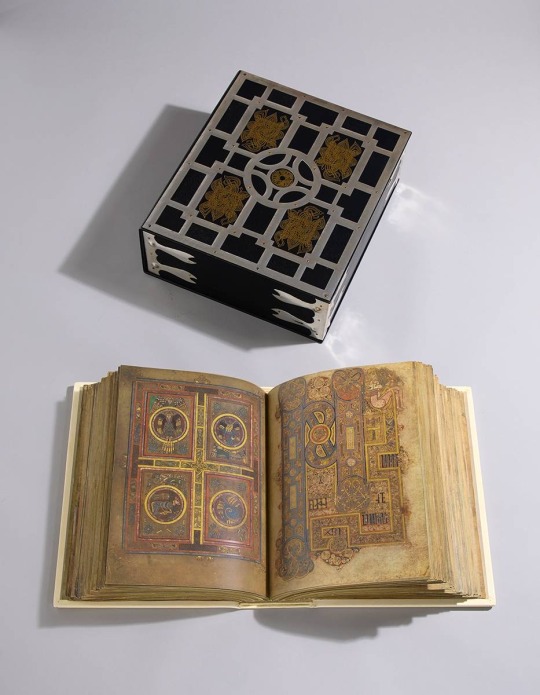
The Book of Kells. A special facsimile.
Faksimile Verlag, Luzern, 1990. The Book of Kells, the most precious illuminated European manuscript of the early Middle Ages, now reproduced, the first and only complete facsimile, published by Authority of the Board of Trinity College, Dublin. Large folio, Luzern 1990, Number 1,304 of 1,480, fine white tawed leather over wooden boards. Contained in a specially created presentation box, the embossed surface with blind & gilt tooled Celtic decoration and silver and brass mounts. Together with a commentary volume with illustrations, 'The Official Guide to The Book of Kells' by Dr Bernard Meehan, former Keeper of Manuscripts at Trinity College, Dublin. A rare opportunity to acquire a complete facsimile of one of the World's greatest Art Treasures.
Whytes
107 notes
·
View notes
Text

The Best Way to Remove the Cold
By David A Arnold:
The great preacher, Alexander Whyte (1836 – 1921), when he was too old to mount the pulpit, would rise every morning to prepare a sermon, even though he never preached them. He did so until the day he died. He was convinced that study of the Word was essential to saving himself.
In Psalm 119:25 the psalmist stated, “My soul clings to the dust; revive me according to Your Word.” “Clings” means “glued to, overtaken.” “The dust” speaks of the things of this world and how our flesh seems to be always pulling us toward earthly things and desires. This is why he cried, “Revive me according to Your word.” “Revive me” means “restore, raise me up to life, health, and vigor.” He asks that God do this “according to Your Word.” God’s Word is spirit and life, and, through the power of Scripture, we are revived and gain victory. The best way to remove the cold is to get near the fire. The best way to overcome this clinging of our soul to the dust is to read and meditate on the flame of the Word of God.
“Ninety-nine Christians in every hundred are merely playing at Bible study; therefore, ninety-nine Christians in every hundred are mere weaklings when they might be giants” (R.A. Torrey).
10 notes
·
View notes
Text
Day 15
Banff
Today was a free day just to wander at leisure. It was a fairly lazy day for me, but still included 4 hours on my feet, and over 200 photos!
Started with a walk down The Avenue (Banff Ave), and when you look north the skyline is dominated by Cascade Mountain.


I did walk (south) to the Bow River, but I'll show you pics from there later . . .
Most people won't think a magpie is all that exciting, but our magpies don't look like this!


Stopped in at the Whyte Museum of the Canadian Rockies, which had some interesting interactive displays about the national parks and railways and the people behind them, but I really liked the exhibition of artworks about birds.


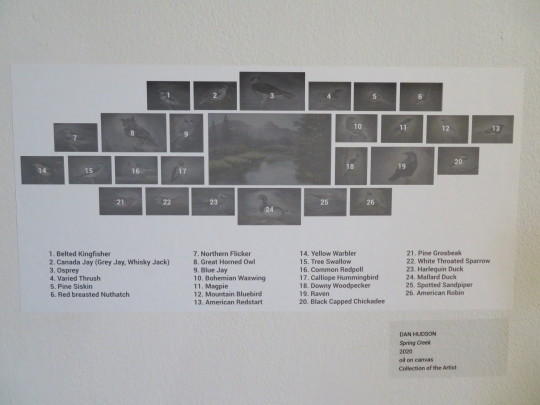
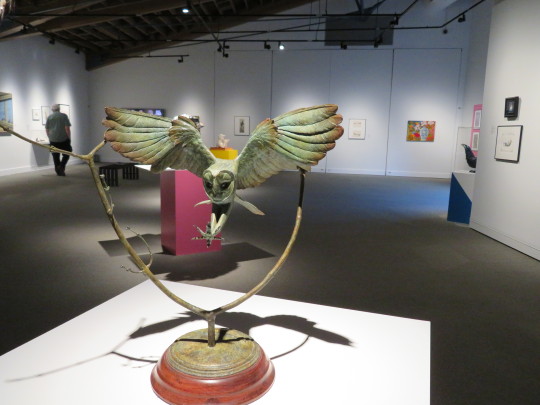
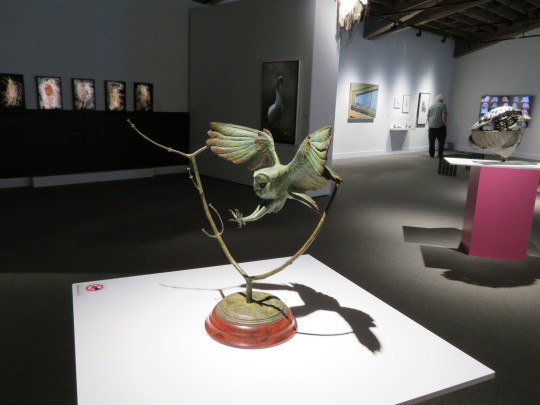
Owl sculpture in bronze is called Slipstreaming and is by Niel Clifford
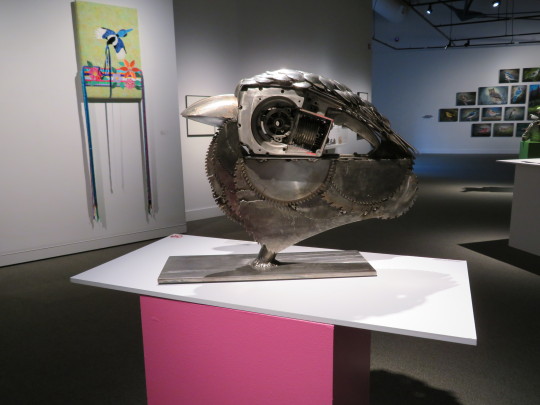

Steel sculpture called Little Bird by Peter McFarlane

and this one called Owl which is ink on paper by Robert J Hope looked kind of 3D as I approached it on an angle, but I couldn't capture that effect with the camera.

Okay, photos from the Bow River. I'm not sure what mountains are in these shots, maybe Norquay and Edith?

This one is Mount Rundle

and from the other side of the river we can look back across as Cascade Mountain.
Next stop was the Buffalo Nations Luxton Museum. Wandered through the gift shop before I went in and loved these buffalo horn carvings, but chickened out of buying the one that was begging me to take it home.

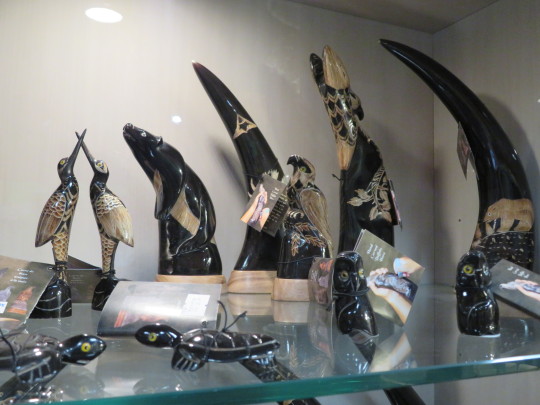
(The eagle near the middle of the second pic was the one I nearly bought.)
Inside they had a bunch of life-sized diorama displays, but I was mostly fascinated by the clothing/accessories, baskets etc decorated with porcupine quills and beads (which came later after trading with Europeans began).
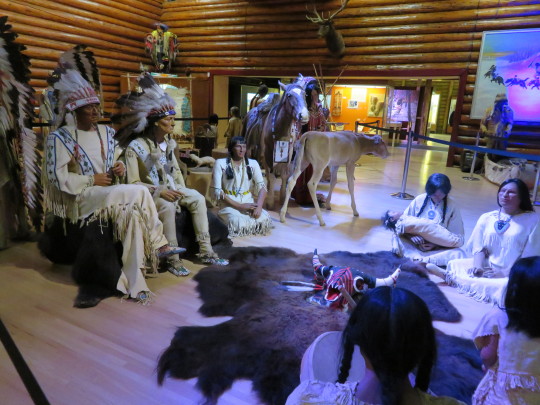

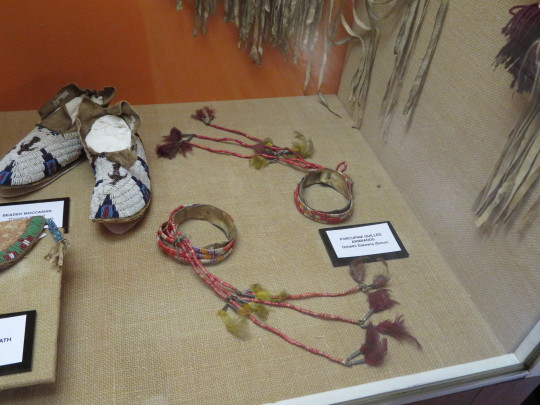

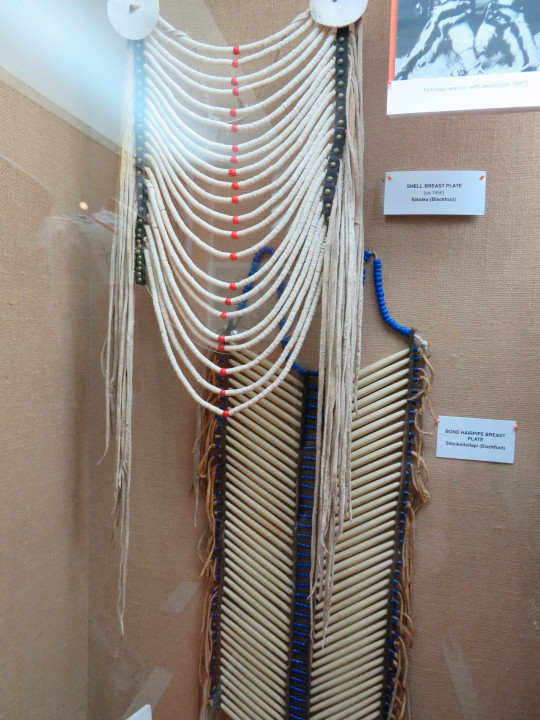


How cool are these head pieces!

Getting close to the 30 pic limit again!!! So, just a couple of pics from the grounds of the Cascades of Time Gardens.

This impressive building is the headquaters/admin building for the Banff National Park. It's made from Rundle Stone.




Gonna say it again . . . 30 images is not enough! But then, I did have to choose from over 200! And I know I did not do justice to the things I saw with just these few, but I hope you get the idea! (and that I did not bore you with my photo spam)
#my big north america adventure#day 15#banff#alberta#canada#yeah I know I take way too many photos#I am worse now than I was with film cameras!#but I was bad then too!
5 notes
·
View notes
Text
BREAKING: NEW LANDS DISCOVERED BY NASAZUR'S VOYAGE!

Nadalger Nasazur has returned, by some miracle, from his expedition sponsored by Salgon, bearing exciting news. Rather than coming around the other side, he announces that he had successfully found La Occidente, the Western lands. He named, charted, and claimed three islands which he explored after sailing southeast.
Nasazur recounts his first thoughts during his landfall on the first landmass he step foot on, Costa Justa.
"I first did notice the fair and whyte beaches of this land which did welcome the bann'r of Salgon comf'rtably and easily. I wouldst name this land: Costa Justa, and claim it for Salgon.
The sky was shimmering blue, as mine nose. The sea was shining blue, as mine nose. The sand was glistening white as mine no- as mine leg. The climate was warmful and comfort-rich, as mine leg. "
Nasazur then, to his surprise, encountered a party of what he assumed to be this land's locals. He described them as
"Grene and Slimeous"
The natives and Nasazur and his crew had a stare off for a good 7 minutes. Not one moved. Nasazur then broke the awkward silence and apparently heroicly stepped forward and said:
"HO! Holla, Greetings, O Weird and Grene Symians! I am NADALGER NASAZUR, world-famous explorer for the Crown of Salgon! Kneel before me, and then go fetch me thy golds and opals and also your KING so HE may also kneel before me!"
The locals reportedly just stared back, without a hint of understanding. Realizing they did not speak Luxardish, Lucet OR Roncevalois (what sort of barbarians are these?) Nasazur then decided to wave his rapier around at them, banking on them understanding his might. They instead responded by beating him to a pulp with their spears.
"By Snod, Fie! I hadst never witnessed such barbarities in my most handsome life. We would do well to skewer this cabal of Cantankerous Swampdoodles like the Eastern Shrike. Yet, one kind Beastie, a lonesome forlorn Womanly-specie, in an act of unusual hospitalities, thus invited me, in some disgusting gutteral bunkum, to Design her as mine own loyal steed, and mount her so I may capture this lands treasures!"
Nasazur and his party then set out with one local who may or may not have willingly agreed to collaborate with the explorers. Nasazur would go on to leave a small outpost of 15 men on Costa Justa before charting two other islands, dubbed Isla Mardis and Isla Cuferion, before returning home with captured slaves, funny rocks, ugly artwork, and most importantly, GOLD!
It is expected Queen Luísa will order a second expedition to continue the no-longer Lunatic attempt to circumnavigate the world. What this means for Luxardy and Casuara at large will soon be witnessed.
2 notes
·
View notes
Photo

Day 15: Pennsylvania Railroad GG1
Information from Wikipedia:
The PRR GG1 was a class of electric locomotives built for the Pennsylvania Railroad (PRR), in the northeastern United States. Between 1934 and 1943 General Electric and the PRR's Altoona Works built 139 GG1s.
The GG1 entered service with the PRR in 1935 and later ran on successor railroads Penn Central, Conrail and Amtrak. The last GG1 was retired by New Jersey Transit in 1983. Most have been scrapped, but sixteen are in museums.
The GG1 was 79 feet 6 inches (24.23 m) long and weighed 475,000 pounds (215,000 kg). The frame of the locomotive was in two halves joined with a ball joint, allowing the locomotive to negotiate sharper curves. The body rested on the frame and was clad in welded steel plates. The control cabs were near the center of the locomotive on each side of the main oil-cooled transformer and oil-fired train-heating boiler. This arrangement, first used on the PRR's Modified P5 class, provided for greater crew safety in a collision and provided for bi-directional operation of the locomotive. Using Whyte notation for steam locomotives, each frame is a 4-6-0 locomotive, which in the Pennsylvania Railroad classification system is a "G". The GG1 has two such frames back to back, 4-6-0+0-6-4. The related AAR wheel arrangement classification is 2-C+C-2. This means one frame mounted upon a set of two axles unpowered (the "2") and three axles powered (the "C") hinged with the ball and socket to another frame of the same design (the +). The unpowered "2" axles are at either end of the locomotive. The GG1 was equipped with a Leslie A200 horn.
A pantograph on each end of the locomotive body was used to collect the 11,000 V, 25 Hz alternating current (AC) from the overhead catenary wires. In operation, the leading pantograph was usually kept lowered and the trailing one raised to collect current, since if the rear pantograph failed it would not strike the forward pantograph. A transformer between the two cabs stepped-down the 11,000 V to the voltages needed for the traction motors and other equipment. Twelve 385-horsepower (287 kW) GEA-627-A1 traction motors (AC commutator motors, not AC induction motors) drove the GG1's 57-inch (1,448 mm) diameter driving wheels on six axles using a quill drive. The power required was such that double traction motors were used, with two motors driving each axle. The traction motors were six-pole field, 400 volts, 25 Hz rated each at 385 hp (287 kW). The motors were frame-mounted using quill drives to the sprung driving wheels, providing a flexible suspension system across a relatively-long locomotive frame, which allowed full wheel weight to rest on the rail for good traction regardless of track condition. A series-wound commutator motor's speed is increased by increasing the applied voltage to the motor, thus increasing the current through the motor's armature, which is necessary for increasing its torque and thus increasing motor speed. The engineer's cab had a 21-position controller for applying voltage to the motors. Four unpowered leading/trailing wheels were mounted on each end of the locomotive.
In the 1930s, railroad passenger cars were heated with steam from the locomotive. The GG1 had an oil-fired steam generator to feed its train's "steam line."
Beginning in the late 1910s, the PRR received the FF1, but decided that it was too slow for passenger trains; it was relegated to heavy freight service. In the mid-1920s, it received the L5 electric, which had a third-rail power supply at the time. When the Pennsylvania built the O1 and the P5, it chose the P5 over the O1 for its ability and power on the rails. After a grade-crossing accident with the P5, the cab was moved to the center and was designated P5a. PRR still searched for the ultimate electric, since the P5 did not track well at high speeds and was wondering if the P5a could be improved even further. Soon enough, the Pennsylvania was in luck and found two contacts as early as 1932. The mechanical design of the GG1 was based largely on the EP3, which the PRR had borrowed from the New York, New Haven & Hartford Railroad to compare it to the P5a. In 1933, the PRR decided to replace its P5a locomotives; it asked General Electric and Westinghouse to design prototype locomotives with a lighter axle load and more power than the P5a, a top speed of at least 100 miles per hour (160 km/h), a streamlined body design, and a single (central) control cab.
Both companies delivered their prototypes to PRR in August 1934. Westinghouse's R1 was essentially "little more than an elongated and more powerful version of the P5a" with an AAR wheel arrangement of 2-D-2. General Electric delivered its GG1. Both locomotives were tested for ten weeks in regular service between New York and Philadelphia and on a test track in Claymont, Delaware. PRR chose the GG1 because the R1's rigid wheelbase prevented it from negotiating sharp curves and some railroad switches. On November 10, 1934, the railroad ordered 57 locomotives: 14 assembled by General Electric in Erie, 18 by the PRR's own Altoona Works, and 20 more in Altoona with electrical components from Westinghouse in East Pittsburgh and chassis from the Baldwin Locomotive Works in Eddystone. An additional 81 locomotives were built at Altoona between 1937 and 1943.
On January 28 1935, to mark the completion of electrification of the line from Washington, D.C., to New York City, PRR ran a special train hauled by Pennsylvania Railroad 4800 before it opened the line for revenue service on February 10. It made a round-trip from D.C. to Philadelphia; it completed the return leg in a record 1 hour and 50 minutes.
In 1945, a Pennsylvania GG1 hauled the funeral train of President Franklin D. Roosevelt from Washington Union Station to New York Pennsylvania Station.
In the mid-1950s, with declining demand for passenger train service, GG1s 4801–4857 were re-geared for a maximum speed of 90 miles per hour (140 km/h) and placed in freight service. They initially retained their train-heating steam generator, and were recalled to passenger service for holiday-season mail trains and 'Passenger Extras' such as those run for the annual Army–Navy football game in Philadelphia.
Timetable speed limit for the GG1 was 75-80 mph until October 1967, when some were allowed 100 mph for a couple of years. When Metroliner cars were being overhauled in the late 1970s, GG1s were again allowed 100 mph for a short time when hauling Amfleet cars on trains scheduled to run 226.6 miles from New York to Washington in 3 hours and 20 to 25 minutes.
On June 8, 1968, two Penn Central GG1s hauled Robert F. Kennedy's funeral train from New York Penn Station to Washington, D.C.
The first designer for the GG1 project was industrial designer Donald Roscoe Dohner, who produced initial scale-styling models, although the completed prototype looked somewhat different. At some point, PRR hired famed industrial designer Raymond Loewy to "enhance the GG1's aesthetics." The final design is retrospectively 'Art Deco' as we know it today.
Although it was thought until 2009 that Loewy was solely responsible for the GG1's styling, Dohner is now understood to have contributed as well. (Dohner's GG1 designs influenced the modified P5as, which debuted before the GG1 — not, as was thought, the other way around.) Loewy did claim that he recommended the use of a smooth, welded body instead of the riveted one used in the prototype. Loewy also added five gold pinstripes and a Brunswick green paint scheme.
In 1952, the paint scheme was changed to Tuscan red; three years later, the pinstripes were simplified to a single stripe and large red keystones were added.
On September 6 1943, the Congressional Limited crashed at Frankford Junction, in the Kensington neighborhood of Philadelphia, Pennsylvania, in the United States. The train was pulled by GG1 4930. The accident was caused by a journal box fire (a hot box) on the front of the seventh of the train's 16 cars. The journal box seized and an axle snapped, catching the underside of the truck and catapulting the car upwards. It struck a signal gantry, which peeled off its roof along the line of windows "like a can of sardines". Car #8 wrapped itself around the gantry upright in a figure U. The next six cars were scattered at odd angles over the tracks, and the last two cars remained undamaged. In total, 79 passengers died, all from cars #7 and #8, and 117 were injured, some seriously.
On January 15 1953, train 173, the overnight Federal from Boston, was approaching Washington behind GG1 4876. The train passed a signal 2.1 miles (3.4 km) north of Union Station between 60 and 70 miles per hour (97 and 113 km/h), and the engineer decreased the throttle and started applying the brakes. When the engineer realized that the train was not slowing down, and applying the emergency brake had no effect, he sounded the engine's horn. A signalman, hearing the horn and noting the speed of the 4876, phoned ahead to the station master's office. 4876 negotiated several switches at speeds well over the safe limits and entered the station at around 35 to 40 miles per hour (56 to 64 km/h). The train demolished the bumping post, continued through the station master's office and into the concourse, where it fell through the floor into the station's basement. Thanks to the evacuation of the concourse, no one died, either in the station or aboard the train. A temporary floor was erected over the engine, and the hole it created, for the inauguration of President Dwight D. Eisenhower. 4876 was eventually dismantled, removed from the basement and reassembled with a new frame and superstructure in Altoona. The reconstructed 4876 survives at the B&O Railroad Museum in Baltimore.
The accident was determined to have been caused by a closed "angle cock", a valve on the front and rear of all locomotives and rail cars used in the train's airbrake system, on the rear of the third car in the train. The handle of the angle cock had been improperly placed and had contacted the bottom of the car. Once it was closed, the air brake pipe on all the cars behind the closed valve remained at full pressure, keeping the brakes released on those cars while the brakes on the locomotive and first three cars were applied in emergency. The only major electro-mechanical breakdown of the GG1 was caused by a February 1958 blizzard that swept across the northeastern United States and put nearly half of the GG1s out of commission. Exceptionally fine snow, caused by the extreme low temperatures, passed through the traction motors' air filters and into the electrical components. When the snow melted, it short-circuited the components. On about 40 units, the air intakes were later moved to a position under the pantographs.
In 1968, the PRR, with its 119 surviving GG1s, merged with the New York Central Railroad to form Penn Central. Penn Central went bankrupt in 1970 and its freight operations were later assumed by government-controlled Conrail, which used 68 GG1s in freight service until the end of electric freight traction in 1980.
After its creation in 1971, Amtrak purchased 30 GG1s for $50,000 each and leased another 21, of which 11 were for use on New York and Long Branch commuter trains. Amtrak initially renumbered the purchased GG1s as Nos. 900 to 929; later the railroad added a prefixed "4". This replicated some of the numbers of the leased units, which were renumbered 4930 to 4939, except 4935, which kept its old PRR/PC number.
Amtrak unsuccessfully attempted to replace the GG1s in 1975 with the General Electric E60. An E60 derailed during testing at 102-mile-per-hour (164 km/h), forcing an investigation (the E60 used the same trucks as the P30CH diesel then in service with Amtrak) that delayed acceptance. The hoped-for 120 miles per hour (193 km/h) service speed was never achieved (timetable limit was 90 mph, then 80, then 90).
A replacement was finally found after Amtrak imported and tested two lightweight European locomotives: X995, an Rc4a built by ASEA of Sweden, and X996, a French design. The railroad picked the ASEA design, initially nicknamed the "Swedish swifty" or the "Mighty Mouse" and later often referred to as the "Swedish Meatball". Electro-Motive Diesel, then a part of General Motors, was licensed to build a derivative called the AEM-7. As AEM-7s arrived, Amtrak finally ended GG1 service on April 26, 1980.
The last GG1s in use were some of the 13 assigned to New Jersey Transit (#4872–4884) for its North Jersey Coast Line between New York and South Amboy (the former New York and Long Branch) that ran until October 29, 1983, thus retiring the locomotive after 49 years of service.
Fifteen production locomotives and the prototype were preserved in museums. None are operational; their main transformers were removed because of the PCBs in the insulating oil.
PRR/PC/CR 4800 — Railroad Museum of Pennsylvania, Strasburg, Pennsylvania (nicknamed "Old Rivets" due to it being the only GG1 to have been built with a riveted body)
PRR/PC/CR 4859 — Transportation Center, Harrisburg, Pennsylvania (designated Pennsylvania State electric locomotive in 1987)
PRR/PC/CR/NJT 4876 — B&O Railroad Museum, Baltimore, Maryland (Reconstructed with new frame and superstructure as well as reusable components from the original 4876 following the 1953 Washington Union Station wreck)
PRR/PC/CR/NJT 4877 — United Railroad Historical Society of New Jersey, Boonton, New Jersey (nicknamed "Big Red")
PRR/PC/CR/NJT 4879 — United Railroad Historical Society of New Jersey, Boonton, New Jersey
PRR/PC/CR/NJT 4882 — National New York Central Railroad Museum, Elkhart, Indiana (currently painted in Penn Central colors)
PRR/Amtrak 4890 — National Railroad Museum, Green Bay, Wisconsin
PRR 4903/Amtrak (4)906 — Museum of the American Railroad, Frisco, Texas (hauled Robert F. Kennedy's funeral train with GG1 4901 from New York to Washington on June 8, 1968).
PRR 4909/Amtrak 4932 — Leatherstocking Railway Museum, Cooperstown Junction, New York
PRR 4913/Amtrak (4)913 — Railroaders Memorial Museum, Altoona, Pennsylvania
PRR 4917/Amtrak 4934 — Leatherstocking Railway Museum, Cooperstown Junction, New York
PRR 4918/Amtrak (4)916 — National Museum of Transportation, St Louis, Missouri
PRR 4919/Amtrak (4)917 — Virginia Museum of Transportation, Roanoke, Virginia
PRR 4927/Amtrak 4939 — Illinois Railway Museum, Union, Illinois
PRR 4933/Amtrak (4)926 — Central New York Chapter of the National Railroad Historical Society, Syracuse, New York. It has been cosmetically restored and is on display at the NYS Fairgrounds Historic Train Exhibit.
PRR 4935 / Amtrak 4935 — Railroad Museum of Pennsylvania, Strasburg, Pennsylvania (nicknamed "Blackjack")
During the mid-1930s, many railroads streamlined locomotives and passenger cars to convey a fashionable sense of speed. While the Union Pacific had the M-10000 and the Chicago, Burlington & Quincy Railroad the Zephyr, the PRR had the GG1. The GG1 has "shown up over the years in more advertisements and movie clips than any other locomotive." It was also featured in art calendars provided by PRR, which were used to "promote its reputation in the public eye."
PRR-painted GG1s appear in the films Broadway Limited in 1941, The Clock in 1945, Blast of Silence in 1961, the 1962 version of The Manchurian Candidate, and Avalon in 1990. Two GG1s appear in the 1973 film The Seven-Ups—a black Penn Central locomotive and a silver, red and blue Amtrak locomotive. A Penn Central GG1 also appears in another 1973 film The Last Detail. PRR GG1 4821 appears briefly in the 1952 film The Greatest Show on Earth, hauling the Ringling Bros. Barnum & Bailey Circus into Philadelphia's Greenwich Yard, as the movie's director Cecil B. DeMille narrates the scene of its arrival. Near the end of the 1951 film Bright Victory, GG1 #4849 is shown pulling into the station.
A GG1 and the Congressional were featured on a postage stamp as part of the United States Postal Service's All Aboard! 20th Century American Trains set in 1999.
The PC games Railroad Tycoon II, Railroad Tycoon 3, Sid Meier's Railroads!, Train Fever, Transport Fever and Transport Fever 2 allow players to purchase and operate GG1 locomotive engines on their train routes. The GG1 is also available with the default Trainz Simulator Games in recent years, and is available as add-ons for Railworks, Train Simulator by Dovetail Games and Microsoft Train Simulator.
Model GG1s have been produced in G, O, S, HO, N and Z scales by Rivarossi, Bachmann, Tyco, Lionel, MTH, USA Trains, Kato, Astor, Fine Art Models, Marklin and other manufacturers.
models and route by: Protrainz, Auran, and Download Station
#PRR#Pennsylvania Railroad#Pennsy#PRR GG1#Pennsylvania Railroad GG1#GG1#Electric Locomotive#Trains#Trainz Simulator#Advent Calendar#Christmas#Christmas 2022 🎄🎅🎁
4 notes
·
View notes
Text
Episode 191 - Dark Fantasy
This episode we’re discussing the fiction genre of Dark Fantasy! We talk about horror, grimdark, violence, amoral protagonists, epic fantasy vs small scale fantasy, the importance of tone, and more!
You can download the podcast directly, find it on Libsyn, or get it through Apple Podcasts or your favourite podcast delivery system.
In this episode
Anna Ferri | Meghan Whyte | Matthew Murray | Jam Edwards
Things We Read (or tried to…)
Berserk by Kentaro Miura (Wikipedia)
The Citadel of Fear by Francis Stevens (Gertrude Barrows Bennett)
Coraline by Neil Gaiman
The Lies of the Ajungo by Moses Ose Utomi
Every Heart a Doorway by Seanan McGuire
Shadowland by Peter Straub
Flowers for the Sea by Zin E. Rocklyn
Twice Cursed edited by Marie O'Regan and Paul Kane
Other Media We Mentioned
Dark Souls (Wikipedia)
Elden Ring (WIkipedia)
Magic Knight Rayearth by CLAMP
Pet Shop of Horrors by Matsuri Akino
The Library at Mount Char by Scott Hawkins
The Coldest Girl in Coldtown by Holly Black
The Cruel Prince by Holly Black (Episode 147 - Contemporary Fantasy)
Monstress by Marjorie Liu and Sana Takeda (Wikipedia)
Ravenloft (Wikipedia)
Nettle and Bone by T. Kingfisher
Leech by Hiron Ennes (Episode 184 - Horror)
The Salt Grows Heavy by Cassandra Khaw (Episode 176 - Fantasy)
Norylska Groans by Michael R. Fletcher and Clayton W. Snyder
Porky Pig's Haunted Holiday (Wikipedia)
The Sandman by Neil Gaiman and various artists (Wikipedia)
Children of Men (Wikipedia)
The Children of Men by P.D. James
Fables by Bill Willingham and various artists (Wikipedia)
Deerskin by Robin McKinley
Links, Articles, and Things
Dark fantasy (Wikipedia)
Category:Dark fantasy anime and manga
Category:Dark fantasy video games
Grimdark Magazine
20 Dark Fantasy by BIPOC Authors
Every month Book Club for Masochists: A Readers’ Advisory Podcasts chooses a genre at random and we read and discuss books from that genre. We also put together book lists for each episode/genre that feature works by BIPOC (Black, Indigenous, & People of Colour) authors. All of the lists can be found here.
The Stardust Thief by Chelsea Abdullah
Children of Blood and Bone by Tomi Adeyemi
Eleventh Cycle by Kian N. Ardalan
To Shape a Dragon's Breath by Moniquill Blackgoose
The Book Eaters by Sunyi Dean
Funeral Songs for Dying Girls by Cherie Dimaline
The Hurricane Wars by Thea Guanzon
The Year of the Witching by Alexis Henderson
The Library of the Dead by T.L. Huchu
Babel, or the Necessity of Violence by R. F. Kuang
The Changeling by Victor LaValle
Jade City by Fonda Lee
She Who Became The Sun by Shelley Parker-Chan
Tread of Angels by Rebecca Roanhorse
Tender Beasts by Liselle Sambury
Witches Steeped in Gold by Ciannon Smart
Sorrowland by Rivers Solomon
An Ember in the Ashes by Sabaa Tahir
The Lies of the Ajungo by Moses Ose Utomi
The First Binding by R.R. Virdi
Give us feedback!
Fill out the form to ask for a recommendation or suggest a genre or title for us to read!
Check out our Tumblr, follow us on Instagram, join our Facebook Group, or send us an email!
Join us again on Tuesday, April 2nd we’ll be talking about the format of Non fiction Graphic Novels and Comics!
Then on Tuesday, April 16th we’ll be giving an update on Media we’ve recently enjoyed!
0 notes
Text
Countries Around the World Wish Israel a Happy Modern 75th Birthday, But Israel Is Over 3000 Years Old and is the Most Important Nation in the World Because They Are God's Chosen People, Like it or Not. Daniel Whyte III, President of Gospel Light Society International, Said in an Earlier Article Today That God's Chosen People -- the Jews -- Always Rise to the Top and to the Forefront to Become World Leaders and World Changers in Every Field. No Matter How Much You Hate Them or Try to Destroy Them, Like Cream, They Always Rise to the Top, and That Blessing of God on Them Cannot be Stopped, and Every Word God Said About Them in the Bible is Coming to Pass and Will Come to Pass. Today, we are Celebrating the Power of God on the Jewish People as we Celebrate Their 75th Modern Birthday, a People Who Lost Over 6 Million Souls in the Holocaust and Then, Within a Few Years, Miraculously Gathered Back Into Their Biblical Historical Ancestral Homeland of Israel and With God's Help Defended Themselves Against Multiple Enemies That Surrounded Them and Were Determined to Push Them Into the Sea, Now is the Leading Nation of the World and the Nation That the World Follows in Important and Significant Areas as the World Did Recently When the Coronavirus Plague Hit the World.
The 75th anniversary Independence Day ceremony, held at Mount Herzl, Jerusalem on April 25, 2023. (photo credit: YONATAN SINDEL/FLASH90)
Countries Around the World Wish Israel a Happy Modern 75th Birthday, But Israel Is Over 3000 Years Old and is the Most Important Nation in the World Because They Are God’s Chosen People, Like it or Not. Daniel Whyte III, President of Gospel Light Society…

View On WordPress
0 notes
Photo

If you're a business owner or work in an industrial setting, you understand the importance of ensuring a safe working environment. The occupational health and safety of your team is essential to your success. Whyte Ridge provides complete Winnipeg power vac services for small and large commercial settings. Our diesel-powered truck-mounted suction and air compressor are ideal for industrial applications. We use top-of-the-line negative air machines that turn your entire duct work into one giant vacuum cleaner.
0 notes
Text
Trực Tiếp Bóng Đá Hôm Nay Trên Vtv6, Vtv2, K+
Đáng chú ý, trong bản danh sách sẽ có sự góp mặt của 5 cầu thủ đang cùng Đội tuyển Việt Nam tham gia thi đấu Vòng loại thứ ba FIFA World Cup 2022 khu vực châu Á. Trận này, ĐT Việt Nam thiếu vắng Trọng Hoàng và Đình Trọng. Nhưng với các cầu thủ còn lại, chúng ta hoàn toàn có thể đặt niềm tin nếu như họ thi đấu cẩn trọng, không chủ quan như Thái Lan. Trận này do Next Media cầm bản quyền, chia sẻ với VTV nên chúng ta có thể theo dõi trên đa nền tảng.
Để thể hiện quyết tâm cao nhất, LĐBĐ Thái Lan đã làm việc với các đội bóng giúp HLV Polking có được những con bài chất lượng nhất. tony mount những nhân sự chất lượng cùng quyết tâm cao nhất, ĐT Thái Lan được đánh giá sẽ dễ dàng giành trọng vẹn three điểm trước Đông Timor trong ngày ra quân. Vietnammoi.vn tổng hợp nguyên văn thông tin từ một số cơ quan thông tấn, báo chí trong nước theo quy định. Chúng tôi sẽ cập nhật thông tin ngay sau khi nhận thấy các thông tin gốc có thay đổi; đồng thời tuân thủ các quy định hiện hành về trách nhiệm phản hồi, đính chính, cải chính... Đề nghị người dùng tham khảo thông tin gốc đồng thời dẫn nguồn chính xác theo cơ quan báo chí phát hành thông tin trong trường hợp trích dẫn một phần hoặc nguyên bản các thông tin do Vietnammoi.vn tổng hợp. Người dùng tự chịu trách nhiệm, bao gồm nhưng không giới hạn trách nhiệm về bản quyền, trong trường hợp này.
Lionel Messi một lần nữa ghi tên mình vào lịch sử bóng đá khi vượt qua số bàn thắng của huyền thoại Pele nhờ cú đúp cho PSG ở Champions League. Trận đấu mở màn của giải bóng chuyền vô địch các CLB nam Thế giới 2021 đã diễn ra một cách vô cùng kịch tính và hấp dẫn giữa 2 CLB đến từ khu vực Nam Mỹ. Thầy trò Antoine Hey buộc phải giành 3 điểm trận này để nuôi hy vọng đi tiếp và có thể họ sẽ được toại nguyện. Thậm chí, Myanmar sẽ làm công việc sút tung lưới đối thủ tốt hơn Thái Lan. Rốt cục, Myanmar cũng có đợt tấn công ra hồn đầu tiên khi bóng được chuyền ban khá nhịp nhàng nhưng cuối cùng cú dứt điểm căng của Hlaing Bo Bo đã không thắng được thủ môn Junildo Pereira.
Dưới sự dẫn dắt của nhà cầm quân tài năng người Đức là ông Antoine Hey, Myanmar hoàn toàn có thể mơ về chiến thắng đầu tiên tại giải đấu ngày ra quân. BNEWS/TTXVN cập nhật trực tiếp kết quả xổ số miền Bắc hôm nay, thứ Tư ngày eight tháng 12 năm 2021. Theo dõi kết quả, lịch thi đấu và bảng xếp hạng AFF Suzuki Cup 2021. Xem trực tiếp Việt Nam vs Indonesia xem link HD, trận đấu thuộc vòng loại World Cup.
Bảng xếp hạng bao gồm các số liệu thống kê để bạn dễ dàng nắm bắt tình hình, so sánh, đối chiếu kết quả của các đội. Bạn sẽ ngay lập tức tìm được lịch thi đấu mới nhất, kết quả trận đấu, tư vấn soi kèo, và tỷ lệ kèo nhà cái. 5 năm trước Lịch thi đấu bóng đá hôm nay (27/6) có những trận đấu đáng chú ý Italia vs Tây Ban Nha, Anh vs Iceland và trận chung kết Copa America.
Thượng đỉnh Nga-Mỹ diễn ra trong không khí không thù địch nhau nhưng cũng không thân thiện. Bộ Ngoại giao và một số địa phương của Việt Nam phối hợp với Bộ Ngoại giao Trung Quốc, Chính quyền tỉnh Vân Nam, Trung Quốc tổ chức Hội thảo. Townsend và Demarai Gray đều đã gây ấn tượng trong màu áo câu lạc bộ mới ở mùa giải này chắc chắn có được sự tin tưởng của Benitez. Thông tin từ Ban Chỉ đạo phòng chống dịch Covid-19 tỉnh Thanh Hóa, tính từ 16h, ngày 07/12 đến 16h, ngày 08/12, tỉnh ghi nhận 219 bệnh nhân mắc Covid-19 mới.
Nhận định Bayern vs Barcelona, bảng E Champions League (3h ngày 9/12). Quyết định được WBC đưa ra hôm thứ Ba vừa qua yêu cầu Tyson Fury thực hiện nghĩa vụ bảo vệ danh hiệu trước Dillian Whyte. Champions League mùa này chứng kiến tới 2 đội toàn thắng ở vòng bảng. Trước đó cũng có 7 CLB khác thực hiện được kỳ tích tương tự. [newline]Các đợt tấn công của Myanmar tỏ ra tương đối đơn điệu nên dễ dàng bị hàng thủ số đông của Timor Leste dễ dàng bẻ gẫy. Số 11 Mouzinho của Timor Leste thực hiện vài động tác "múa could" cùng trái bóng bên cánh phải, cũng một phần do chẳng thấy đồng đội nào dâng lên hỗ trợ. Cuối cùng khi thấy bóng áo đỏ xuất hiện, anh mới thực hiện đường căng ngang vào trong nhưng hậu vệ Myanmar đã kịp can thiệp chịu phạt góc.
Cái khó lúc này là nên sử dụng Đỗ Hùng Dũng như thế nào tại AFF Cup 2020 để giúp cầu thủ này có được phong độ tốt nhất trong trận chung kết. Ở cặp đấu giữa Real Madrid vs Inter tại lượt cuối vòng bảng Champions League, đoàn quân của HLV Ancelotti đã thể hiện đẳng cấp để giành chiến thắng 2-0 chung cuộc, qua đó vào vòng knock-out với ngôi nhất bảng D. Chiến thắng 3-0 ngay ở lượt ra quân trước Myanmar đem đến sự hứng khởi cho Singapore. Tuy nhiên, đối thủ tiếp theo của chủ nhà là Philippines, đội tuyển sở hữu lực lượng nhỉnh hơn hẳn. Là hai đội bóng trắng tay ở ngày ra quân, hẳn là cả Myanmar vs Timor Leste đều đang quyết tâm giành thắng lợi ở trận đấu thứ hai vào chiều nay, 8/12.
Có những thời điểm, đoàn quân của ông Antoine Hey kiểm soát bóng chủ động hơn, tạo ra những cơ hội ăn bàn khá rõ ràng. Ưu thế ấy được thể hiện qua những miếng lên bóng đầy tốc độ của bộ đôi hậu vệ và tiền vệ cánh phải David Htan và Maung Maung Lwin. “Tôi nghĩ ở trận đấu với Malaysia, chiến thuật của đội tuyển Việt Nam cũng không có quá nhiều sự thay đổi. Ở các trận đấu kế tiếp, đội tuyển Việt Nam lần lượt gặp Malaysia và Indonesia.
#mason mount đội hiện tại#tony mount#mason mount chiều cao#mason mount người yêu#mason mount champions league#middlesbrough đội hình#ảnh mason mount#ảnh mason
1 note
·
View note
Video
Enjoying Views at 2134 meters (7002 ft) Banff National Park by Mark Stevens
Via Flickr:
A view at the Lake Agnes Tea House to peaks of Devil's Thumb and Mount Whyte, and I loved how the still present snow brought out some nice contrasts with the rocks and peaks off in the distance. This is a view to the southwest where I zoomed in to the mountain peaks.
#2134 meters#7002 ft#Banff National Park#Blue Skies with Clouds#Canadian Rockies#Capture NX2 Edited#Color Efex Pro#Day 2#Devil's Thumb#Evergreens#Hike to Lake Agnes Tea House#Hillside#Hillside of Trees#Lake Agnes Tea House#Looking SW#Mount Whyte#Nature#Nikon D800E#Portfolio#Project365#Snowcapped#Trees#Wintry Landscape#Alberta#Canada#flickr
0 notes
Text

The Happy Mountain
Shrunken in my old age,
snowcap thinning,
more cracks and wrinkles
but glad to be here still.
The sun warms my body
and you visit,
often.
Making happy noises
when you reach my summit.
We're both glad to be here
then.
Inktober #27
Wednesday 27th October 2021
#inktober#doodle#train doodle#drawing#ink#black and white#mountain#mount fuji#happy#sky#poemoftheday#poems on tumblr#poetry#landscape#evans and whyte
1 note
·
View note
Text
By Moonlight
On AO3 here.

For the @riverdalepromptathon week 2, a little highwayman story.
The prompts
location: Whyte Wyrm /activity: magic /emotion: angry/ color: orange /lyrics: i came down to meet you in the half light the moon left
With that he put a foot in a stirrup and swung up into the saddle. Mounted on the great horse, his feathered hat was almost as high as her window ledge. As she watched he reached up his hand toward her. For all his swagger there was an entreaty in the gesture, something vulnerable and yearning. She leaned out and placed her fingers into his palm and he stood in the stirrups to bring it to his lips in a courtly gesture, which he immediately ruined by licking her finger and grinning mischievously. “I so wanted to know the sweetness of that orange Betty. I longed for it as I watched you eat it. Will you let me have a proper taste next time?” She gasped and snatched her hand back as he laughed and spurred Bess out through the courtyard and away, followed by his clerk, if that was what he was, out onto the moonlit road as it unrolled before him like a ribbon.
The song? Well it's a pretty British kind of story so let's have an English folk song about the most famous of the highwaymen Dick Turpin. (If the voice is familiar it's because it’s Colin Meloy of the Decemberists).
youtube
54 notes
·
View notes
Text

A mahogany gamesman's travelling roulette wheel, the ivory handled brass-mounted mahogany wheel with 44 coloured segments, the painted canvas odds sheets with four colours and harp, Victorian crown and Prince of Wales feathers symbols, in japanned tin case.
Whyte’s
16 notes
·
View notes
Photo
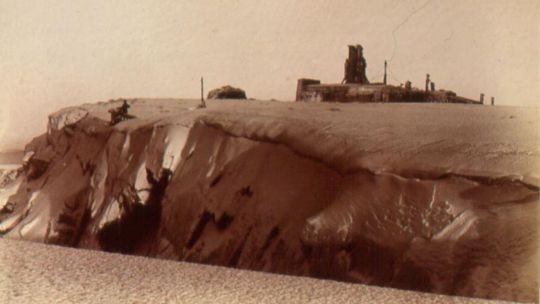




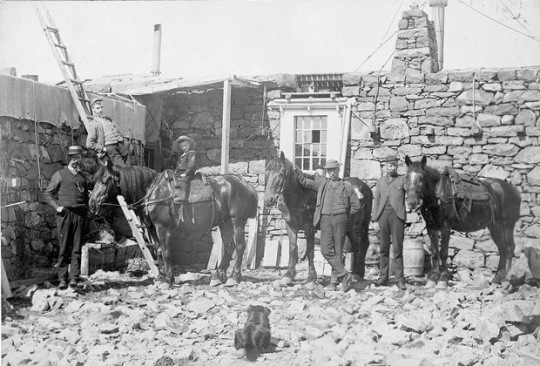
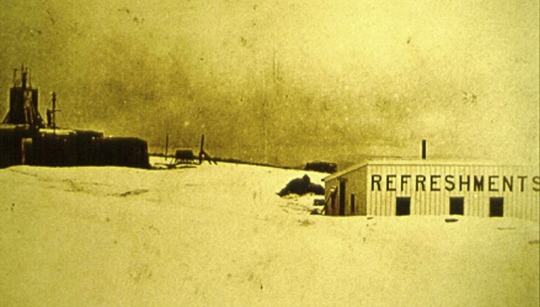

I've just discovered it is World Meteorological Day so I managed to dig up a topical post.
Opened on the 17th October 1883, the Ben Nevis Observatory provided invaluable meteorological data for 20 years on a continuous hourly basis from the top of our highest mountain.
The Observatory was funded mostly from a list of private donations which included Queen Victoria.
The Observatory was managed by the Scottish Meteorological Society and the Royal Societies of Edinburgh and London. The building was manned by a superintendent and two assistants who were responsible for taking readings. During the long dark days of winter, staff would brave gale force, icy winds and driving snow to carry out their labours. Inside heat was provided by an open cooking stove in the kitchen and a closed one in the office - fuelled mostly by paraffin coke. Visitor charges for the Observatory were one shilling per person or three shillings per horse for using the track to the top of Nevis.
Now I think quite a few of you out there already knew about the Observatory, I have posted before about it, but I think few of you will have known about The Ben Nevis Observatory Hotel.
In 1885 Fort William hotelier Robert Whyte opened the hotel, an annexe built onto the observatory. For over thirty years, the Observatory Hotel offered weary travellers a place to hang their hats and rest their heads.
Having taken just 10 days to build, the hotel (which only had four bedrooms and was run by a tiny team of two ladies) was open only during the summer months. Interestingly it was a temperance hotel and did not serve alcohol.
In the “midst of a drizzling rain and a stiff breeze” Ben Nevis’ Observatory Hotel opened for the first time on 7 July 1885. The Scotsman reported that a party of 17 gentlemen ascended the mountain to witness the cutting of the red tape.
Even in the 19th century, thousands of people were ascending Ben Nevis every month, and many travellers bemoaned the lack of respite upon reaching its summit. Your night's stay was the reasonable sum of 10 shillings a night, including dinner and breakfast. Lunch was charged separately at just 3 shillings.
A popular offer taken up by the more affluent in society was to hire a pony and guide for 21 shillings to assist you up to the top, before enjoying a night’s stay in the country’s ‘top’ hotel.
The hotel even made use of the observatory, transforming it into a refreshments room following its abandonment in 1904.
Over the next few decades the hotel fell into disrepair, and in 1950 a group of climbers was spotted stripping the lead from its roof and rolling it down the mountain. Allegedly the climbers sold it to fund a Mount Everest expedition.
37 notes
·
View notes
Photo

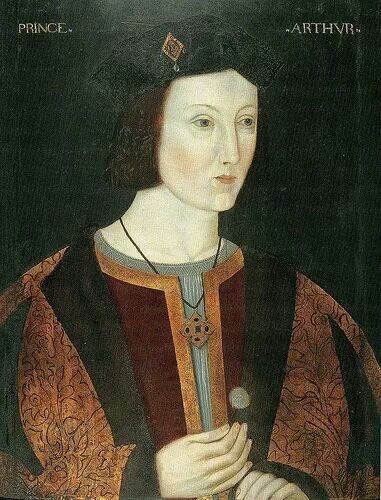

The Dream Couple ... that never came to be
The English may have lived in a foggy island and spoken a strange and barbarous tongue, but they were famous for their piety as the Castilians themselves, and that was a powerful consideration. Catherine’s mother, Isabella, had become a wife and a ruler by force of circumstances, but the rigour of her piety caused her to be known as ‘the crowned nun’. Catherine inherited some of that rigour, partly by nature and partly by education. Together with the pride of ancient royal blood, this was to give the gentle-seeming girl who rode into London to the plaudits of the crowd in October 1501 that steely determination, which was to be her chief characteristic, and one of the most potent political facts of English history.
Henry VII was inordinately proud of his new daughter-in-law:
… and sent divers great lords and knyghtes to convey her with triumphe towards her spouse & husband. And upon the xii daye of November, she was conveyed from Lambeth through London with all triumphe and honoure that could be devised or ymagened, to the Bishops paleys, by the Cathedrall churche of s. Paules. [Hall’s Chronicle]
The pageantry was the most splendid and sophisticated that the city had ever seen, or was to see again for many years. A stage, or mount was then erected in the nave of St Paul’s, and:
Upon the daye of saynct Erkenwald, then benynge Sundaye the sayde layde was ledde to the same mount, and there prynce Arthur openly espoused her, bothe benynge cladde in whyte, both lusty and amorous … [Hall’s Chronicle]
The Prince of Wales may have looked lusty and amorous upon his wedding day, but in fact he was a fragile youth just path his fifteenth birthday. This fact was well enough appreciated by some of his father’s advisers, but unfortunately the question of immediate cohabitation became a political issue. The King was uncharacteristically indecisive, and the Spaniards were divided, some remembering the fate of Prince Juan in similar circumstances. However, Catherine’s confessor, assuming an authority which he probably did not possess, announced that it was the express wish of their Catholic Majesties that the young couple should live together at once, and no one felt confident enough to gainsay him. Before Christmas, therefore, Arthur and Catherine set off for Ludlow, where he had been symbolizing his father’s authority for several months, and a muchenhanced household, both English and Spanish, went with them.
Little is known about their lives during the next four months, leaving ample room for imaginative reconstruction of what went on within the somewhat grim castle where the Prince’s council endeavoured to establish the realities of peace and good order within the marches. Catherine as yet spoke no English and little French, but Arthur’s Latin was probably up to basic communication, and both would have found the Welsh generally spoken by the local people entirely incomprehensible. Quite apart from the attentions which her husband may have paid her, the Princess was well cared for, not only by her formidable duenna, Dona Elvira Manuel, but also by Arthur’s chamberlain, Sir Richard Pole, and his wife. Margaret Pole was the daughter George, Duke of Clarence, and consequently a Princess of the royal blood. It was probably at this time that the friendship between the two women, which was to survive the ravages of fortune over many years, first began to form. Arthur died on 2 April 1502 of ‘consumption’, which in this context probably means pneumonia rather than tuberculosis, leaving his parents devastated and his bride, as far as we can tell, still a virgin. Catherine did not see the rain-soaked pomp of her husband’s funeral at Worcester Cathedral three weeks later. She too was ill, and it was not until the warmer weather came that she could be moved by easy stages to London.
Arthur’s death had many consequences, beyond the distress of his seventeen-year-old widow.”
- David Loades, The Six Wives of Henry VIII
66 notes
·
View notes

